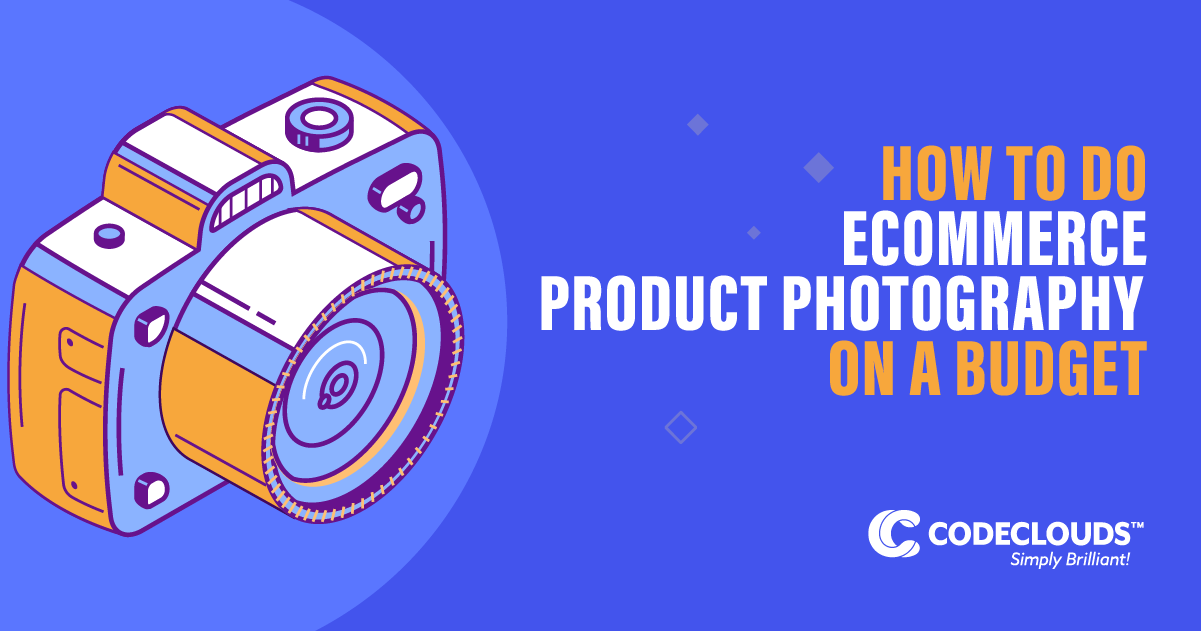Overview
Ecommerce product photography seems hard to do on a budget, which is often necessary for small businesses. But good eCommerce photography is necessary—because it increases your sales—and is doable. Let’s look at our top tips for how to do eCommerce product photography on a budget—from using natural lighting to making the most of free image editing software and optimizing your photos for SEO.

Practice and consistency are key to mastering the art of product photography, and for small businesses, the right approach, even on a modest budget, can yield impressive results in reaching out to potential customers.
Why Does Good Ecommerce Product Photography Matter?
You can’t just upload any product image onto your site and expect conversions. Quality eCommerce product photography matters. Here’s why:
- It decreases your bounce rate: Customers find sites with good photography trustworthy, so they are more likely to stay and buy.
- Makes you stand out in a saturated market: Good product photography helps you stand out from your competitors, especially if you sell on sites like Amazon.
- Customers care about images: Customers think images are important—in fact, 90% of online shoppers believe image quality matters. Also, images are informative and easier to digest than words.
- Decreased returns: Good product photography decreases returns and increases customer satisfaction because customers are less likely to return items which look like they did on the website.
- Branding: Product photography is a brilliant branding tool to showcase your brand’s visual image through packaging and product lineups.
Top Tips For Ecommerce Product Photography:
Now you know why you should put effort into good eCommerce product photography, let us show you how with these top tips:
Have A Good Set Up
The right setup and equipment to help with product photography is the key to your success. Let’s look at what you need:
High Quality Camera
You can’t take good photos with a bad camera. That’s why it’s best to take product photos on a DSLR camera, which is what professionals use. However, even a second-hand DSLR is expensive and, fortunately, these days you can take pretty good photos with a phone camera. (Then, again, it needs to be a decent camera).
Having a high quality camera is important because you must take high resolution product photos.
Tripod
A good camera is nothing without a tripod. As product photography needs a low shutter speed, you probably won’t be able to hold the camera still long enough to take a clear picture. Thus, having a tripod helps you steady the camera and ensure you don’t take blurry photos.
Good Lighting
Lighting can make or break a photo and has to be just right to give your photos a professional finish. The main issue is exposure, as you need the right amount of light to show off your products. You have two different options for lighting—natural sunlight or artificial light.
A natural light setup is cheaper and easier for beginner photographers because you don’t need to worry about equipment. You can set up a natural lighting set up in a room with a window, using white poster boards, bounce cards and a white background to reflect light onto the product. Of course, natural light is affected by what time of the day it is.
An artificial light set up is more difficult, though you can now buy much of the equipment at cheap prices online. Also, you need lots of equipment and more advanced photography knowledge to set up artificial lights.
Now that you have the equipment, you need to know…
How To Take The Pics?
Once you’ve got your set up, your next step is taking the photos themselves:
Include The Whole Product
It’s important to photograph the entire product, so that customers get a good look at what they’re buying. Not photographing the whole product means that there’s a risk of customers going elsewhere or returning your product because they expected something different.
Consider Doing Different Types of Product Photos
Product photography isn’t just pictures of a single product on a white background. There are different types of photos you can take:
- Product only: Product only is the simplest type of product photography, just the product without a background or any packaging.
- Group: You can photograph groups of products if you are selling them together, to advertise a special deal or to show off your range.
- Packaging: Showing products with packaging is a great way to do branding, but also useful to let customers know your brand cares about eco-friendly packaging.
- In context: In context product photos are perfect for demonstrating your products’ use to customers or how your products fit into their life.
- Scale: Showing products in context to show how big they are is a good way of showing their value for money.
- Detail: For products with a lot of small details, it’s a good idea to have a few close up shots.
Take Lots of Pics
Always take lots of photos to make the most of your setup and ensure you get at least a few good captures from every angle. However, you should also take lots of shots to make sure to take several different types of photos:
- Close ups: Detail photos, as mentioned above, help customers get a closer look at your product.
- 360° views: Customers love to see a product from every angle, so make sure to take enough pictures to give them a 360°. A rotating table-top platform, also known as a Lazy Susan, is a good idea for a smooth rotation with evenly spaced photos.
Taking these types of photos increases customer satisfaction and decreases returns.
Use The Right Camera Settings
To do great product photography, you need to use the right camera settings:
- Use your camera’s largest photo size and the Superfine setting for a high quality image. (If you have the right camera and access to an image editing program, you should shoot in RAW).
- Set WB (White Balance) to Auto.
- Set ISO to an appropriate level for your environment’s light to reduce noise.
- Set your f-stop (aperture) to the highest setting to get rich depth of field. (This will decrease your shutter speed, which is why you need a tripod).
- Fiddle around with the exposure until it looks right if you can. Some cameras may have an Aperture Priority setting or an exposure compensation dial, which you can also use.
Don’t have a camera? There are still ideal settings for product photography such as the portrait mode on an iPhone. With a phone, you can also choose what part of the image you want to be exposed by clicking on it.
Image Editing
Image editing is essential to make your product photography look more professional. Let’s take a look at how you can do the image editing you need to produce brilliant product photos:
Use Apps
While you can outsource your image editing, it’s relatively easy to do it yourself. You have several options:
- Apps like Pixlr, Fotor, Canva or Snapseed.
- A professional image editing program like Photoshop (or Photopea, a free online alternative), if you know how to use it.
It’s better to edit the image on your computer because of the larger screen size (and the capacity to use more powerful tools).
Remove The Background
Unless you are doing product photography in context, you must remove the background (i.e. make it transparent). This is easy enough to do with an app like Canva, Photopea or various background removal tools online.
To keep the background transparent, save your image as a PNG.
Add Color Options
If you offer a product in different colors, you should have photos of it on your website in all the different colors. Due to image editing software, you don’t need to take photos of every color, you can edit them afterwards, however take care to accurately represent the colorways if you do this.
Optimize for SEO
You have to factor in SEO for product images, as with everything else on your website. Optimizing your product images for SEO optimization is important because very large images can affect your page loading and therefore your SEO ranking. Then again, you also want to have high quality images. This means you have to find the sweet spot between fast page loading and quality when sizing your images.
Another thing to remember for SEO when uploading your product image, is to include alt-text for screen readers.

Anyone (including you) can do eCommerce photography—without breaking the bank. Good eCommerce photography is essential for the success of your business; fortunately, if you follow the tips we’ve given you in this article—from using a good camera to optimizing for SEO—your small business can have product photography to match the best. If you’d like to get a fresh facelift for your online store to match those fresh new product photos, consider hiring a front end developer from CodeClouds!
If you would like to learn more about eCommerce, check out our blog comparing Magento vs Shopify vs BigCommerce to see which eCommerce platform is right for you!
Share this article
407 reads
Similar Reads








